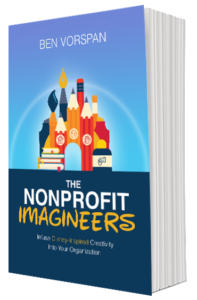
Walt Disney had a vision for a clean, family friendly theme park. When Walt wanted to migrate the concepts from his imagination into tangible drawings for what would become Disneyland, he first approached his friend Welton Becket to ask where he could find the right architect to turn his vision into a buildable plan. Becket responded, “You’ll use architects and engineers, of course, but Walt – you’ll really have to train your own people; They are the only ones who will understand how to accomplish your idea.”
This quote from Marty Sklar in the forward to Walt Disney’s Imagineering Legends and the Genesis of the Disney Theme Park illustrates a problem most non-profits face, in that we hire people for specific, pre-existing job titles with the expectation that they perform those exact jobs. The foundation of our business practices is that each person has a specific expertise. We hire bookkeepers to do the bookkeeping, program directors to plan programs and communications managers to send emails. It makes sense. But it also restricts us from truly exercising our creative muscles. When was the last time your bookkeeper was asked her opinion on how to better reach millenials? When was the last time your janitor was asked to help plan your next big event?
We need to train Nonprofit Imagineers
We stay in our lanes because that’s what we were trained to do and is expected of us. But is that the way it should be? I can’t tell you how many times I’ve run an idea by our head of maintenance and received feedback about crowd flows, acoustics, and which appetizers are least popular, and always left in the walk-in fridge the next day, leading me to completely change my plans. Why shouldn’t he be involved on some level in helping plan events? It’s not easy to convince an accountant to share her thoughts on adult education, and it’s even harder to convince an executive director that 10% of that accountant’s time should purposely be diverted to anything and everything other than accounting. But just as Walt’s neighbor explained, you need to train your people to think like you. It won’t come naturally.
“Any ride engineer can design parts.” Don Hilsen, Disney Imagineer, said. “But it is a unique kind of engineer who can blend a creative story and theme with practical technology… You have to be a big thinker, a ‘blank sheet of paper’ person.” The truth is, there are more than one hundred Imagineering disciplines at Disney, including accountants, writers and landscapers – just like the crew at your organization. Imagineers aren’t trained by the Disney company to be accountants or writers – they come to the organization with that skill set and then are trained to think and interact differently, from within their chosen field.
Deep down, we all have the ability to imagineer! Somewhere, there’s a blank sheet of paper inside each of us. When given the right motivation and flexibility, and provided with the proper tools to be creative, we can do what Walt once did, and what Disney Imagineers do every day – change the way we perform our jobs and build something totally different. I’ll go out on a limb here and say that at the time of writing this book, no non-profit in history has ever hired someone to be in-house Imagineer. That’s because, unless you’re the Disney company, you can’t hire imagineers (well, except for Alcoa – the company credited with first coining the term “imagineering” as a way of encouraging creative uses for their aluminum products during World War II) – but you can hire bookkeepers, program directors and communications managers and train them to imagineer!
 Celebrate 2 years of Imagineering!
Celebrate 2 years of Imagineering!
Comments are closed